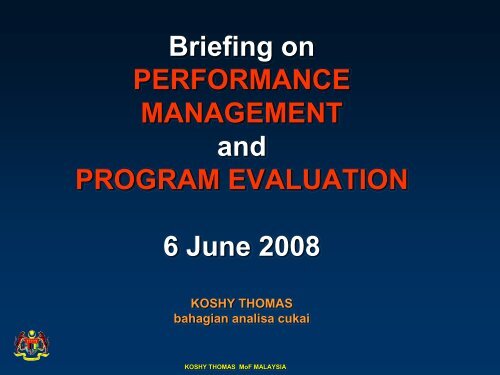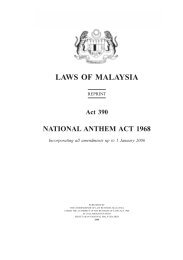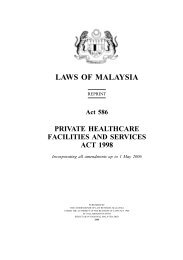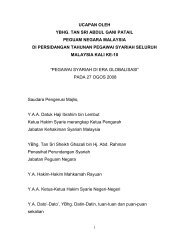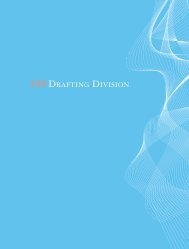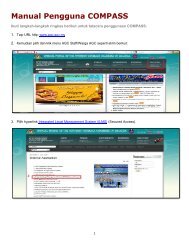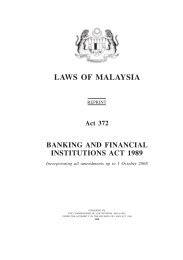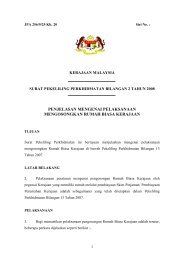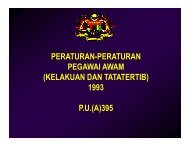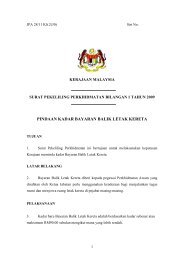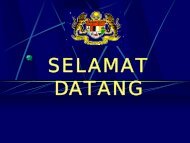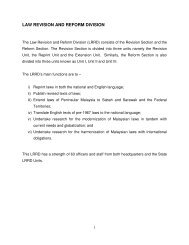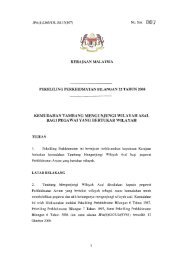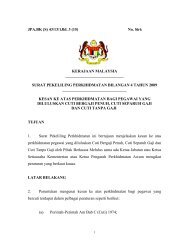program evaluation
program evaluation
program evaluation
You also want an ePaper? Increase the reach of your titles
YUMPU automatically turns print PDFs into web optimized ePapers that Google loves.
Briefing on<br />
PERFORMANCE<br />
MANAGEMENT<br />
and<br />
PROGRAM EVALUATION<br />
6 June 2008<br />
KOSHY THOMAS<br />
bahagian analisa cukai<br />
KOSHY THOMAS MoF MALAYSIA
presentation will cover<br />
• performance management<br />
• modified budgeting system<br />
• <strong>program</strong> <strong>evaluation</strong><br />
• internalised self <strong>evaluation</strong><br />
• jawatankuasa pemandu penilaian<br />
<strong>program</strong>
presentation will cover<br />
• performance management<br />
• modified budgeting system<br />
• <strong>program</strong> <strong>evaluation</strong><br />
• internalised self <strong>evaluation</strong><br />
• jawatankuasa pemandu penilaian<br />
<strong>program</strong>
performance management<br />
• performance management is a<br />
process of defining a mission and<br />
desired outcomes, setting<br />
performance standards, linking<br />
budgets to performance, reporting<br />
results, and holding public officials<br />
accountable for those results<br />
…….National Academy of Public Administration<br />
United Kingdom<br />
KOSHY THOMAS MoF MALAYSIA
performance measurement<br />
• is the comparison of actual levels of<br />
performance to pre-established<br />
target levels of performance<br />
• to be effective, performance<br />
measurement must be linked to the<br />
organizational strategic plan<br />
KOSHY THOMAS MoF MALAYSIA
how we measure performance<br />
will depend largely on:<br />
~ the strategic framework<br />
~ the strategic plan<br />
~ the targets<br />
~ the M&E framework, and<br />
~ the reporting mechanism<br />
KOSHY THOMAS MoF MALAYSIA
strategic <strong>program</strong> cycle<br />
planning<br />
<strong>evaluation</strong><br />
RBM<br />
BSC<br />
VBM<br />
EFQM<br />
implementation<br />
monitoring<br />
KOSHY THOMAS MoF MALAYSIA
presentation will cover<br />
• performance management<br />
• modified budgeting system<br />
• <strong>program</strong> <strong>evaluation</strong><br />
• internalised self <strong>evaluation</strong><br />
• jawatankuasa pemandu penilaian<br />
<strong>program</strong>
Chart 2: PROGRAM AGREEMENT & ProLL RELATIONSHIP<br />
T<br />
I<br />
M<br />
E<br />
L<br />
I<br />
N<br />
E<br />
ProLL CHART<br />
Beneficiaries<br />
Clients<br />
Needs/Problems<br />
Policies<br />
Activities<br />
Input<br />
Process<br />
Task<br />
Outputs<br />
Impact/Outcome<br />
© Rasappan 1996<br />
Need<br />
Fulfillment<br />
Long Term<br />
Strategies<br />
Short Term<br />
Strategies<br />
Objectives<br />
EVALUATION<br />
NEEDS<br />
APPRAISAL/<br />
EX ANTE<br />
APPROPRIATENESS/<br />
EFFECTIVENESS<br />
EFFICIENCY<br />
IMPACT/<br />
EX POST<br />
PROGRAM AGREEMENT<br />
CLIENT IDETIFICATION<br />
• Client (Internal, External, Direct, Indirect)<br />
• Stakeholders (Direct Indirect)<br />
• Target Groups<br />
• Service Providers (Internal & External)<br />
NEEDS/PROBLEM ASSESSMENT<br />
• Identify Real Needs & Problems<br />
• Associate it with Clients Groups<br />
• How to Address These Needs<br />
Problems<br />
POLICIES<br />
• Activity Mandates (Legal/Administrative)<br />
• Sectoral & National Policies<br />
ACTIVITIES & OBJECTIVES<br />
• Identification of Functions<br />
• To Achieve Objectives<br />
• To fulfill Needs & Overcome Problems<br />
INPUTS & STRATEGIES<br />
• Seek Money, Man & Methods by Function<br />
• To Implement Activities by Function<br />
• Through Specific Strategies<br />
TASK<br />
• Undertaken by Man using Money and<br />
Methods<br />
• Resource Optimisation key to Success<br />
OUTPUTS<br />
• Specification of Goods and Services in<br />
• Qnty, Qlty, Time & Cost<br />
IMPACT INDICATORS/EVALUATION<br />
• Key Performance indicators<br />
• Key Result Areas<br />
• Proposed Evaluation Plan<br />
OBJECTIVE<br />
ACHIEVED<br />
KOSHY THOMAS MoF MALAYSIA
aligning strategy<br />
• national level-vision plan, OPP<br />
• sector level-<strong>program</strong> goals<br />
• ministry level-agency goals,AMB1<br />
• activity level-activity goals, ABM2<br />
KOSHY THOMAS MoF MALAYSIA
ABM 1<br />
agency level information<br />
• agency objectives<br />
• source of authority of the agency<br />
• agency strategies<br />
• agency financial resources (aggregated)<br />
• agency manpower resources (aggregated)<br />
KOSHY THOMAS MoF MALAYSIA
PROGRAM ACTIVITY STRUCTURE<br />
ACTIVITY 1<br />
DESIGNS<br />
SUB ACT.1<br />
ICT/ADMN FUNC<br />
FUNCTION 1<br />
Hill Terrain<br />
TASK 1<br />
Taskforce Meetings<br />
SUB ACT.2<br />
CORE BUSINESS<br />
Road Designs<br />
FUNCTION 2<br />
Wet Lands/Swamp<br />
TASK 2<br />
Design Preparations<br />
SUB ACT.3<br />
CORE BUSINESS<br />
Bridge Designs<br />
FUNCTION 3<br />
Coastal<br />
TASK 3<br />
Data & Research<br />
All Aspects<br />
of the<br />
Activity<br />
is<br />
Documented<br />
in the<br />
Program<br />
Agreement<br />
MAN, MONEY AND METHODS EMPLOYED IN GENERATING THE<br />
DESIRED OUTPUTS AT THE ACTIVITY LEVEL<br />
KOSHY THOMAS MoF MALAYSIA
presentation will cover<br />
• performance management<br />
• modified budgeting system<br />
• <strong>program</strong> <strong>evaluation</strong><br />
• internalised self <strong>evaluation</strong><br />
• jawatankuasa pemandu penilaian<br />
<strong>program</strong>
FEATURES OF MBS<br />
EXPENDITURE TARGET<br />
PROGRAM AGREEMENT<br />
AND EXCEPTIONS REPORT<br />
PROGRAM EVALUATION<br />
A MORE GENERALIZED<br />
APPROACH TO<br />
EXPENDITURE CONTROL<br />
Perbendaharaan Malaysia<br />
KOSHY THOMAS MoF MALAYSIA
what is <strong>evaluation</strong>?<br />
a systematic approach to asking<br />
questions about what a <strong>program</strong> is doing<br />
and providing evidence of what it is<br />
accomplishing in order to provide<br />
guidance for future direction<br />
KOSHY THOMAS MoF MALAYSIA
<strong>evaluation</strong> assists agencies to:<br />
• better manage its <strong>program</strong>s<br />
• improve the delivery of its <strong>program</strong>s<br />
• challenge the direction of its <strong>program</strong><br />
• allow the organization to account for its<br />
performance<br />
KOSHY THOMAS MoF MALAYSIA
utility of <strong>program</strong> <strong>evaluation</strong><br />
• to improve <strong>program</strong> performance<br />
• increase accountability<br />
• improve quality of management decisions<br />
• improve distribution of resources<br />
• inter agency performance can be<br />
measured<br />
• management tool to improve <strong>program</strong><br />
performance<br />
KOSHY THOMAS MoF MALAYSIA
formative <strong>evaluation</strong><br />
• a continuous or on going assessment<br />
of the efficiency and effectiveness of a<br />
<strong>program</strong>’s processes<br />
• to ensure that the <strong>program</strong> is on track<br />
towards achieving the mandated<br />
outcomes<br />
• concurrent or predictive in nature<br />
(preventive)<br />
KOSHY THOMAS MoF MALAYSIA
summative <strong>evaluation</strong><br />
• a critical assessment of the performance of<br />
a <strong>program</strong> to determine its effectiveness,<br />
efficiency, economy and appropriateness to<br />
assist decision makers decide the need for,<br />
nature of & continued existence of prevailing<br />
<strong>program</strong>s.<br />
KOSHY THOMAS MoF MALAYSIA
<strong>evaluation</strong> issues & focus<br />
• appropriateness<br />
• effectiveness<br />
• efficiency<br />
• economy<br />
KOSHY THOMAS MoF MALAYSIA
APPROPRIATENESS EVALUATION<br />
assist decision makers in deciding whether<br />
there is a need for a new <strong>program</strong> and if so,<br />
should the government deliver it;<br />
OR<br />
whether there is a continuing need for an<br />
existing <strong>program</strong>, and if so, should the<br />
government deliver it.<br />
© ARTD Malaysia<br />
KOSHY THOMAS MoF MALAYSIA
EFFECTIVENESS EVALUATIONS<br />
concerned with measuring the extent to<br />
which objectives and outcomes are<br />
being achieved, measuring the factors<br />
that affect achievement of the outcomes,<br />
AND<br />
establishing cause-effect interpretations<br />
about the extent to which it can be<br />
claimed that the <strong>program</strong> caused the<br />
outcomes.<br />
© ARTD Malaysia<br />
KOSHY THOMAS MoF MALAYSIA
EFFICIENCY EVALUATION<br />
examines the extent to which<br />
<strong>program</strong> inputs are minimized for a<br />
given level of <strong>program</strong> outputs<br />
© ARTD Malaysia<br />
KOSHY THOMAS MoF MALAYSIA
ECONOMIC EVALUATION<br />
the term economy can often be used<br />
to distinguish between being<br />
efficient and yet being wasteful<br />
© ARTD Malaysia<br />
KOSHY THOMAS MoF MALAYSIA
presentation will cover<br />
• performance management<br />
• modified budgeting system<br />
• <strong>program</strong> <strong>evaluation</strong><br />
• internalised self <strong>evaluation</strong><br />
• jawatankuasa pemandu penilaian<br />
<strong>program</strong>
what is internal <strong>evaluation</strong>?<br />
• internal <strong>evaluation</strong> is <strong>evaluation</strong> conducted<br />
by a person or group directly associated<br />
with the organization or <strong>program</strong> that<br />
supports organisational development and<br />
intentional change<br />
• under the new paradigm, development<br />
<strong>evaluation</strong> is being viewed as an ongoing<br />
learning process<br />
KOSHY THOMAS MoF MALAYSIA<br />
© ARTD Malaysia
major internal <strong>evaluation</strong> design<br />
strategies<br />
• external contractors<br />
– <strong>evaluation</strong>, accountability, comparative learning<br />
– not permanent employees<br />
– independent of <strong>program</strong> teams and managers<br />
– report and recommend<br />
• independent internal <strong>evaluation</strong> unit<br />
– <strong>evaluation</strong> and continuous quality improvement<br />
(CQI)<br />
– may include planning, accountability, learning<br />
– independent of <strong>program</strong> teams and managers<br />
– report, recommend, advocate<br />
KOSHY THOMAS MoF MALAYSIA<br />
Adapted from: Love (1998)
major internal <strong>evaluation</strong> design<br />
strategies<br />
• embedded internal <strong>evaluation</strong> function<br />
– evaluative inquiry, monitoring, CQI, OD, learning<br />
– responsibility of managers or team leaders<br />
– integral part of <strong>program</strong> and project teams<br />
– report, recommend, advocate, manage, fix<br />
• hybrid internal <strong>evaluation</strong> function<br />
– <strong>evaluation</strong>, CQI, accountability, OD, learning<br />
– external contract evaluators link with internal<br />
<strong>evaluation</strong> unit or staff with <strong>evaluation</strong> roles<br />
– report, recommend, advocate, manage, fix, plan<br />
KOSHY THOMAS MoF MALAYSIA<br />
Adapted from: Love (1998)
IE MODEL<br />
• have ownership over the <strong>evaluation</strong> process.<br />
• objective to improve not to prove.<br />
• facilitate using the process and results for <strong>program</strong> improvement<br />
and decision making.<br />
• improved communication and shared understanding between<br />
different groups<br />
• <strong>evaluation</strong> is ingrained in the day-to-day operations of an<br />
organisation<br />
• <strong>evaluation</strong> is a developmental process, not only a report card<br />
process<br />
• an important benefit of <strong>evaluation</strong> is organisational learning -- a<br />
way for the organisation to assess its progress and to change in<br />
ways that lead to greater effectiveness<br />
KOSHY THOMAS MoF MALAYSIA
disadvantages of internal<br />
<strong>evaluation</strong><br />
• less perceived credibility than an external<br />
evaluator<br />
• objectivity may be questioned<br />
• greater potential for bias<br />
• potential for role confusion<br />
• workload may delay completion of <strong>evaluation</strong>s<br />
KOSHY THOMAS MoF MALAYSIA
<strong>program</strong> <strong>evaluation</strong><br />
implementation structure<br />
KOSHY THOMAS MoF MALAYSIA
EVALUATION COMMITTEE<br />
(Treasury)<br />
STEERING COMMITTEE<br />
(Agency)<br />
STUDY COMMITTEE/TEAM<br />
(Activity)<br />
KOSHY THOMAS MoF MALAYSIA
COORDINATING OFFICER<br />
(Treasury)<br />
FACILITATOR<br />
(Agency)<br />
TEAM LEADER<br />
(Activity)<br />
KOSHY THOMAS MoF MALAYSIA
EVALUATION FLOWCHART
ProLL Evaluation Flowchart<br />
© 1999 Arunaselam Rasappan/Jerry Winston<br />
Public Sector Policy & Program Environment<br />
Doing The Right Things<br />
The Right Way<br />
For The Right People<br />
Logical Linkages with Substantive Purpose of Program<br />
Resource Program<br />
Efficacy Improvement Compliance<br />
Design Adjustment<br />
Data Collection<br />
Facilitate<br />
Decision-making<br />
Financial Accountability<br />
Management Accountability<br />
Program Accountability<br />
MBS Program Agreement:<br />
Pilot Testing<br />
• Data Collection<br />
• Data Tabulation & Analysis<br />
• Data Interpretation<br />
• Validity & Reliability<br />
Testing<br />
Data Entry<br />
Stakeholder Utilization<br />
Verify Client Needs & Objectives<br />
Evaluability Assessment<br />
Determine Evaluation Questions<br />
• Identify pre-determined eval<br />
issues<br />
• Analyse <strong>program</strong> agreement<br />
• Conduct stakeholder inventory<br />
• Analyse <strong>program</strong> logic<br />
Prioritze Evaluation<br />
Questions<br />
Data Sources and<br />
Instrumentation<br />
Determine Research Design<br />
Determine Evaluation Design<br />
Information Needed for<br />
Evaluation<br />
Data Validation<br />
Data Analysis<br />
Findings &<br />
Conclusions<br />
• Stakeholder Analysis<br />
of Report<br />
• Stakeholder<br />
Feedback<br />
Evaluation Reporting<br />
• Multiple reports<br />
• Multiple audiences<br />
• User-oriented reports<br />
• Utilization-focussed<br />
reports<br />
Preliminary Planning &<br />
Assessment Stage<br />
Evaluation Design<br />
Stage<br />
Data Collection &<br />
Analysis Stage<br />
Reporting &<br />
Information<br />
35<br />
Utilization Stage
ISE process
FLOW CHART FOR PUBLIC SECTOR PROGRAM EVALUATION UNDER THE THE MODIFIED BUDGETING SYSTEM (MBS) (MBS)<br />
PROGRAM EVALUATION<br />
STEERING COMMITTEE<br />
WORKSHOP 11<br />
PLANNING<br />
WORKSHOP 2 2<br />
INSTRUMENT/CONSTRUCT<br />
WORKSHOP 3 3<br />
DATA DATA ANALYSIS/REPORT WRITING WRITING<br />
1<br />
BY<br />
APPROVAL BY<br />
CONTROLLING OFFICER<br />
1 CONTROLLING OFFICER<br />
4<br />
4<br />
INTERNAL<br />
ASSESSMENT<br />
INTERNAL<br />
ASSESSMENT<br />
2<br />
2<br />
PARTICIPATION<br />
ANALYSIS<br />
PARTICIPATION<br />
ANALYSIS<br />
5<br />
5<br />
PROGRAM LOGIC<br />
PROGRAM LOGIC<br />
1<br />
2<br />
1<br />
2<br />
No<br />
No<br />
Yes<br />
Yes<br />
No<br />
No<br />
Yes<br />
Yes<br />
Yes<br />
29<br />
3<br />
3<br />
No<br />
No<br />
11<br />
11<br />
Yes<br />
29<br />
17<br />
17<br />
18<br />
18<br />
19<br />
19<br />
20<br />
20<br />
27<br />
27<br />
28<br />
28<br />
EVALUABILITY<br />
ASSESMENT<br />
EVALUABILITY<br />
ASSESMENT<br />
STEERING COM<br />
ACTION PLAN<br />
STEERING COM<br />
ACTION PLAN<br />
STEERING COM<br />
INSTRUMENT<br />
STEERING COM<br />
INSTRUMENT<br />
DATA<br />
COLLECTION<br />
DATA<br />
COLLECTION<br />
DATA ENTRY<br />
DATA ENTRY<br />
DATA CLEANING<br />
DATA CLEANING<br />
STEERING COM<br />
DRAFT REPORT<br />
STEERING COM<br />
DRAFT REPORT<br />
FINAL REPORT<br />
FINAL REPORT<br />
FOLLOW-UP<br />
ACTION<br />
FOLLOW-UP<br />
ACTION<br />
1<br />
1<br />
6<br />
6<br />
7<br />
7<br />
8<br />
8<br />
9<br />
9<br />
10<br />
10<br />
KRA/KPI/CSF<br />
KRA/KPI/CSF<br />
OUTCOMES<br />
HIERARCHY<br />
OUTCOMES<br />
HIERARCHY<br />
STAKEHOLDER<br />
ANALYSIS<br />
STAKEHOLDER<br />
ANALYSIS<br />
EVALUATION<br />
QUESTION<br />
EVALUATION<br />
QUESTION<br />
ACTION PLAN<br />
ACTION PLAN<br />
Cross Referencing<br />
Cross Referencing<br />
2 Run Sequence Again<br />
2<br />
Run Sequence Again<br />
1<br />
1<br />
ISOLATE M’ABLE<br />
INDICATORS<br />
ISOLATE M’ABLE<br />
INDICATORS<br />
IDENTIFY DATA<br />
SOUURCES<br />
IDENTIFY DATA<br />
SOUURCES<br />
DRAFT<br />
INSTRUMENT<br />
DRAFT<br />
INSTRUMENT<br />
FIELD TEST/<br />
VALIDATION<br />
FIELD TEST/<br />
VALIDATION<br />
SAMPLING DESIGN<br />
12<br />
13<br />
14<br />
15<br />
16<br />
12<br />
13<br />
14<br />
15<br />
SAMPLING DESIGN 16<br />
2<br />
2<br />
RUN BASIC STATS<br />
RUN BASIC STATS<br />
IDENTIY CROSS-TABS<br />
EVALUATION Q.<br />
GROUPING<br />
QUESTIONAIRE<br />
ITEM ANALYSIS<br />
CONCLUSION &<br />
RECOMMENDATION<br />
DRAFT FIRST<br />
REPORT<br />
21<br />
22<br />
IDENTIY CROSS-TABS22<br />
EVALUATION Q.<br />
GROUPING<br />
QUESTIONAIRE<br />
ITEM ANALYSIS<br />
23<br />
24<br />
25<br />
CONCLUSION & 25<br />
RECOMMENDATION<br />
DRAFT FIRST<br />
REPORT<br />
26<br />
21<br />
23<br />
24<br />
26<br />
© KOSHY THOMAS MoF, Malaysia 2004
controls mechanisms<br />
• peer review through the steering<br />
committee<br />
• meta <strong>evaluation</strong><br />
• internal audits
POLICY MAKERS AND<br />
PLANNERS SHOULD KNOW:<br />
• whether the <strong>program</strong> is producing the<br />
desired outcomes.<br />
• whether there is still a continued need for<br />
the <strong>program</strong>, if so, what are its priorities.<br />
• how efficiently is the <strong>program</strong> producing the<br />
desired results.<br />
• what are the alternatives available in<br />
delivering the <strong>program</strong>.<br />
• whether the <strong>program</strong> should be adjusted,<br />
modified or terminated.<br />
KOSHY THOMAS MoF MALAYSIA
PROGRAM MANAGERS SHOULD<br />
KNOW:<br />
‣ how and why the <strong>program</strong> works and in what<br />
circumstances.<br />
‣ goal to improve the <strong>program</strong> delivery.<br />
‣ framework strategies for continuous improvement.<br />
‣ <strong>program</strong> effectiveness and continued funding.<br />
‣ discover new knowledge about the effective<br />
practice.<br />
‣ improved communication and shared<br />
understanding between different groups.<br />
‣ <strong>evaluation</strong> becomes part of <strong>program</strong> intervention<br />
rather then ‘stand alone’ initiative<br />
KOSHY THOMAS MoF MALAYSIA
terima kasih<br />
thank you<br />
koshy@treasury.gov.my<br />
KOSHY THOMAS MoF MALAYSIA


